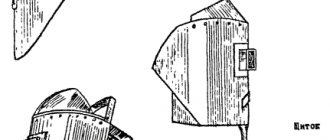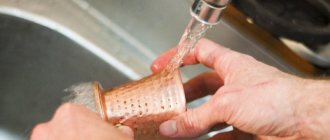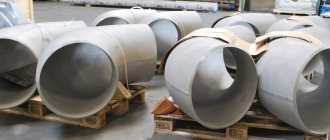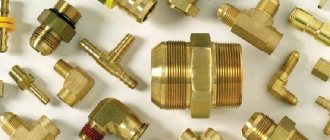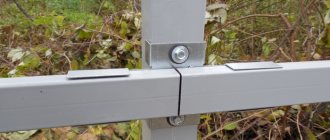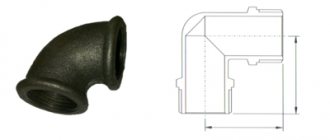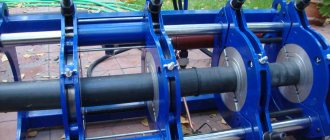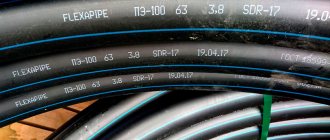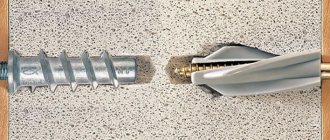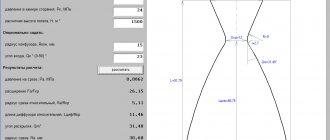Plastic pipes are becoming increasingly popular every year; they are actively used for organizing both cold and hot water supply networks, as well as for installing heating systems. To combine such pipes into systems and to connect them to plumbing fixtures, various connecting elements are used, which include a collet clamp. Collet-type fittings, the use of which does not require special tools and complex equipment, are capable of providing reliable and durable connection of pipeline elements for various purposes. Such clamps can be used both for the installation of pipelines and for connecting plumbing fixtures to the latter.
Straight and angled push-in fittings
Features of collet fittings
The peculiarity of collet fittings is that they are self-sufficient and can be used repeatedly. To install them, you will need a minimum set of tools, most of which are needed to properly prepare the pipe for connection. The collet fittings themselves are installed using a regular wrench or adjustable wrench. The part is held on the pipe using a special compression ring - a collet. The connection is secured with a hexagonal union nut.
The push-in fitting consists of:
- housings with fittings;
- one dielectric and two sealing gaskets on the fitting;
- collets;
- union nut.
The collet is an open metal ring, cut at one end into peculiar “petals”. The distance between the petals is the factor that allows them to move, pressing the pipe against the fitting fitting.
A silicone dielectric gasket is necessary to neutralize static electricity and prevent the development of the electrolysis effect. The electrolytic process inevitably occurs in a system where there is an electrolyte (in this case it could be tap water), an electric current (static electricity) and two different metals (for example, the alloy of the fitting body and the aluminum layer in a metal-plastic pipe). Electrolysis causes intense corrosion of metals and damages the integrity of the pipeline.
The sealing gaskets are two identical, rubber, black. They are pressed by a collet against the inner wall of the pipe, forming a reliable connection with the fitting. As a rule, a high-quality collet fitting comes with 2 additional sealing gaskets from the manufacturer.
How to install
To understand how a straight or angled collet fitting is installed, you can consider this process using the example of installing such a connecting element on a metal-plastic pipe.
- The end of the pipe on which the fitting will be mounted is cut with special scissors strictly at an angle of 90° relative to the axis of the pipe element.
- Since the end of the pipe may be slightly dented after cutting, it must be leveled using a special calibrator. Using the latter, you can also remove the chamfer.
- If a straight or angled collet fitting is used to make the connection, then it must be disassembled at both ends at once by unscrewing the lock nut from the threaded end and removing the o-ring from the fitting. All other types of fittings are disassembled as they are connected to the pipes.
- After disassembling, a straight or angled collet fitting is connected to the pipes in the following sequence: first, a lock nut is put on the pipe, and then an O-ring, after which the area at the end of the fitting around the fitting is lubricated with silicone. The pipe is put on the fitting and pressed against the end of the fitting as tightly as possible.
- To secure the connection being created, the sealing ring is moved towards the end of the connecting product, after which a lock nut is screwed onto the threaded section on its body. The process of tightening the locknut (an open-end or adjustable wrench can be used for this) should be carefully monitored so as not to miss the moment when the operation should be stopped. You should stop tightening the locknut when the elements being connected begin to emit a characteristic creaking sound.
Installing a fitting on a metal-plastic pipe
Thus, the installation process of collet-type fittings is quite simple. To perform it well, you will need attentiveness, accuracy and a minimum set of tools.
What is a collet fitting?
To understand this issue, you need to understand the definition of two terms: collet and fitting.
There is an abundance of fittings on the market made of different materials: plastic, copper, steel, etc.
Installation of a collet fitting on a plastic pipe (sectional view)
They can be used both for a simple connection of two tubes of the same diameter, and as adapters between pipes of different diameters, different materials (for example, the transition from copper pipes to metal-plastic ones), and perform the functions of tees, crosses, corners, plugs, etc.
Thanks to the collet fixation of the fitting, such a connection does not require special knowledge, tools or great physical effort. But at the same time, connections made using this method are sealed and durable.
- collet fittings can be used in the installation of pipelines transporting hot and cold water, gases, oils, and chemical media;
- the temperature of the transported medium should not exceed 175 ºC;
- permissible pressure does not exceed 1.6 MPa;
- the internal diameter of clamp connectors for plastic, metal-plastic or copper pipes presented on the construction market varies from 8 to 100 mm;
- collet fitting can be straight, angled, tee, cross, etc.
Types of collet fittings
- straight collet fitting or coupling. This type is used to connect pipe sections of the same diameter from the same material;
- a transition fitting is required if it is necessary to connect pipes of different diameters or to transition between pipes made of different materials (for example, connecting metal-plastic and metal pipes);
Types of collet fittings (bend, tee, coupling, wall mount)
- A corner or outlet connector is used to arrange corners and turns from 45 to 120 degrees;
- cross - an element that allows the flow to be routed in two directions;
- a tee is used if a one-way branch from the flow is necessary;
- the fitting serves as an adapter from pipe to hose;
- a plug is needed to block the flow at the end of the pipeline.
Advantages and disadvantages
The push-in fitting is the most popular connecting element. This is due to a number of its undeniable advantages:
- affordable price;
- wide range of models;
- Availability of any specialized stores in the assortment;
- ease of installation work that every consumer can handle;
- the possibility of installation using improvised means without purchasing any special equipment;
- tightness and high reliability of joints of metal-plastic, plastic or copper pipes;
- durability;
- Possibility of reusing connecting elements. Thanks to this, collet fittings are convenient to use even in temporary structures;
No special tools are required to install push-in fittings
However, there are some disadvantages:
Main advantages and disadvantages
The clamps used to connect pipes, the basis of which is a collet, began to be used relatively recently, but have already become popular among professional specialists and home craftsmen. The reason for this popularity lies in the advantages of these connecting elements over conventional fittings.
Low cost
This parameter consists of both the price of the clamps themselves and the cost of their installation, which does not require the use of expensive equipment and special tools. It is also important that replacing such connecting elements, if necessary, will also not be associated with serious financial costs.
Availability
Purchasing collet-type fittings for pipes of almost any diameter today does not present any particular problems. In addition, on the modern market you can find collet-type clamps of any size, as well as those designed for pipes made of various materials.
Ease of use
To learn how to efficiently connect pipes using collet clamps, you will need very little time and a minimal set of tools used.
Durability of the created connection
Under normal pipeline operating conditions, a collet-type clamp can last for decades. Only significant mechanical loads and corrosion processes occurring in the pipeline can disable it.
Reliability
This advantage of collet clamps is provided by both the mechanical characteristics of the formed connection and its exceptional tightness.
Reusable
Unlike welds and fittings, which are connected to plastic pipes using heat, push-in fittings can be used repeatedly. This important quality of collet clamps can significantly simplify the process of repairing pipelines for the installation of which they were used. In addition, the ability to reuse push-in fittings allows you to replace individual sections of the pipeline without dismantling the entire system.
Detachable connection of a metal-plastic pipe using a collet fitting
If we talk about the disadvantages of collet-type clamps, then the most significant of them is that such connecting elements weaken over time. This leads to leaks in pipeline systems. Meanwhile, eliminating a leak that has arisen for this reason is not at all difficult: to do this, just tighten the collet fitting.
It is precisely because of this lack of collet clamps that they should be placed in those places in the pipeline where direct access to them is provided. Fitting elements, the basis of which is a collet, cannot be used inside walls or other building structures. Tightening collet fittings to improve their tightness is usually performed no more than once a year.
Inch thread
An inch thread has a profile in the shape of an isosceles triangle with an angle of 55°, which distinguishes it from the profile shape of a metric thread. Thread diameters are measured in inches. The pitch is determined in the number of turns per 1 inch of the length of the threaded part of the product. In industry, threaded connections with an outer diameter of 3/16 to 4 inches are used with the number of turns per inch from 3 to 28. This type of threading is widely used on pipeline parts, as well as on fasteners made in the USA, Great Britain and a number of other countries.
Products with conical inch threads are also available. Thanks to the conical shape, improved tightness of the connection is achieved, which eliminates the need for sealing elements. Conical inch threads are widely used when laying small-diameter pressure pipelines in hydraulic systems.
What are fittings and collets?
To determine the operating principle of the devices, you should first find out what a collet and fitting are. The name of the product comes from the attachment that holds the drill tool. The collet is used to connect cylindrical parts. This is a metal product with a special thread on the side wall that creates several spring petals. Such fittings are often called clamp fittings.
The fitting is a universal connection. It is widely used for different types of tubes. At the same time, the devices are very diverse. This includes straight fittings with different threads, angle fittings, rotary fittings, tees, adapters, double-sided fittings and many others.
Fittings functions:
- Fastening pipelines of different or identical diameters;
- Connections of corner parts;
- Connection of the pipeline with other plumbing fixtures.
The strength of a product is determined not only by the collet. The external fastening nut is also important. Thanks to this, the pipeline is tightly connected, strong and reliable.
Pipe thread
Pipe cylindrical threads are made in accordance with GOST 6357-81. It has a profile in the shape of an isosceles triangle, the angle of inclination of the ridges is 55°. The upper edges of the ridges are rounded. Thanks to this, additional gaps in the area of protrusions and depressions are eliminated, which ensures increased tightness of the connection. Pipe threads are inch threads. Its diameter ranges from 1/16 to 6 inches, and its pitch ranges from 11 to 28 turns.
Compared to other types of inch threads, the pipe thread pitch is reduced. The reduced pitch makes it possible to prevent a critical reduction in the thickness of the pipe wall, which is necessary to maintain the strength characteristics of the pipeline.
Pipe threads can be cylindrical or conical. In the latter case, its taper is determined by the ratio 1:16.
Device, types
Collet clamping equipment for a milling machine includes three main elements in its design:
- frame;
- collet or replaceable sleeve;
- clamping nut.
Longitudinal axial slots on the bushing form movable petals. Their number depends on the diameter of the part. The elements are connected to each other by a lock nut, which transmits pressure to the cone formed by the petals - the device is tightened by radial force. On the construction equipment market, there are replaceable collets with which cylindrical tools are secured. There are blanks in the shape of a polyhedron. The collet clamp is installed on the machine shaft, after which the master performs milling, sharpening or straightening of the parts.
Depending on the function, collets are divided into three types:
- Serving. The sleeve, made of hardened steel, is equipped with three partial cuts with spring tabs directed towards the center of the cartridge. The diameter of the hole in such a clamp is selected with the following condition: the workpiece must be tightly fixed in a stationary position, because in such a case every millimeter is important. The feed collet is equipped with replaceable inserts of different diameters. Then you can work with different-sized workpieces of any configuration.
- Clamping. It differs from the previous sample in that it has a through technological hole with two seats along the axis of the bushing. During processing, the workpiece is tightly clamped in the collet without the risk of falling out. If the master plans to process square parts, he will need a clamp with four slots, and for round and multi-faceted parts, he will need a chuck with three slots. A set of collets for any workpiece will ensure the processing of parts of any shape. The advantage of such a tool is low radial runout.
- Detachable (unclosing) secures parts of small diameter. The design of the expanding collet has springs for spreading the petals.
Each collet is designed for only one diameter, so they are suitable for working with long metal rods mounted on the router.
Read also: Electromagnetic valve for semiautomatic welding machine
Thanks to the high precision of fasteners, taps, a turning cutter or replaceable tips for screwing nuts can be attached to the collet.
The chuck is indispensable if you need to secure a drill in a manual hammer drill or drilling machine. The clamp has a polished inner surface; at the moment of fixation, deformation of the workpiece is eliminated.
In addition to machine tools, collets are used to secure replaceable parts on hand tools. Along with standard devices, there are analogues for installation on mini-drills. In carpentry workshops you can find mechanical tools with collets connecting the working part to the handle. The miniature chuck allows, if necessary, to change the shafts of files or screwdrivers. This principle is inherent in the manufacture of mechanical pencils with replaceable graphite rods. By pressing a button, the user extends a small collet, the petals open, and the rod extends to the specified length.
Advantages and disadvantages
Among the advantages of the device are:
- ease of fixation of the workpiece and its equally easy dismantling;
- possibility of securing miniature workpieces;
- long service life, which depends on the material (hardened or cementitious steel);
- no scrolling of the workpiece due to the large contact area;
- zero radial runout, ensured by good alignment of the part in the bushing. In this way, it is possible to achieve high precision of the process.
- Its versatility makes it possible to use the collet mount on all types of machines.
The only drawback of the collet is that each individual sample fixes a part of the same diameter. For example, a 12 mm collet will only fit a drill of the same size. This problem can be solved by purchasing a set of replacement clamps to match them to workpieces of all diameters and configurations. There is an adapter cylindrical sleeve that is installed in a chuck of the required size, and the workpiece is inserted into it. The clamping nut secures the collet, and it clamps the adapter sleeve to the part. A self-clamping chuck with a set of replaceable clamps or adapter sleeves guarantees high-quality and safe operation on any machine.
HOMEMADE DRILL HOLDER
Quite by chance, I noticed that the length and internal size of the plastic cap from a glass bottle coincided with the length and external size of the electric motor from an inkjet printer, which had long claimed to turn into a miniature hand drill. On the first free evening, I disassembled the plug (it’s easier to have and use two - we break the body of one and take out the inner part, in the second, on the contrary, we save the outer part when disassembling) and adding everything with a front fastening washer, a “tulip” connector and wires, I got the following design:
Which I assembled into a single whole using two screws and three small self-tapping screws.
Adding to this a power supply wire and a specially purchased collet for attaching drills with a diameter of 0.7 to 1 mm. But the seller’s assurances did not come true; the drill collet did not fix a diameter of less than 1 mm.
However, the prospect of “bending” under the pressure of circumstances is not very attractive, and therefore, having strained my brain, I decided to try the following:
The diameter of the “nose” of the syringe on which the needle is installed is slightly smaller than the diameter of the electric motor shaft (2.5 versus 3.2 mm), but the problem can be corrected.
I took a 3 mm drill, increased the diameter, cut what was needed from the body and forcefully pressed it onto the shaft. and nothing happened. The needle did not fit in place, the alignment of the mounted element did not stand up to criticism.
Then I took drills of the following diameters - 2.6 mm, 2.8 mm, 3 mm, 3.1 mm and, with their help, gradually enlarged the hole from the inside of the case.
I slightly modified the hole with a round needle file.
With a little effort, I put the adapter on the shaft and carried out external finishing.
He heated the medical needle over the fire and pulled it out from the installation site with pliers.
The diameter of the extracted needle, 0.7 mm, corresponded to the diameter of the drill being installed, but its shank entered the resulting hole only after applying quite sufficient force.
The next drill had a diameter of 0.8 mm, for which a needle with a corresponding diameter of 0.8 mm (blue plastic) was also found, but for a drill with a diameter of 1 mm there was no suitable needle and the hole from the 0.8 mm needle had to be this use a drill and drill it out. However, installing it using pliers also required some effort.
The nuances of using socket pipe connections
The socket connection is distinguished by its simplicity. So the end of one pipe has a larger size, where the necessary element is inserted. To seal the connection, various types of seals are used.
Types of socket connections:
- Without O-ring;
- With O-ring;
- By welding.
The first option is characterized by maximum simplicity. To begin with, the materials are measured and prepared (sawed off, sanded). Then the prepared pipe is inserted into the socket. The gap is sealed with a sealant. Compaction occurs due to oiled hemp or flax. The material is pushed deeper. And the nearest distance is treated with silicone sealant.
When using an O-ring, the required tightness is ensured by this rubber element. The ring is clamped between the walls of the pipe and the socket
It is important to monitor the alignment of the centers
The use of welding is only possible with special equipment. This is how a mechanical or manual welding machine is used. The installation process is quite simple: the elements are heated and connected.
Types of plumbing pipes and connections
There is a lot of material for making pipes. Each option has its own characteristics, advantages, disadvantages and recommendations for use. The main thing is to familiarize yourself with the basic information.
Types of pipes:
- Metal;
- Plastic;
- Metal-plastic.
For the first option, steel, copper and stainless steel are most often used. Plastic pipes are represented by polymer, polypropylene and cross-linked polyethylene. Metal-plastic communications are a combination of plastic and metal.
Among all the options, metal-plastic is very popular. Among the advantages are the smoothness of the internal walls, corrosion resistance, easy installation, and durability. The main disadvantage is the connection features.
Plastic is also widely used due to its corrosion resistance and smooth surface. Metal is slowly becoming a thing of the past. Despite all its strength, the material is prone to corrosion. At the same time, installation is quite difficult, because it only requires welding.
When using metal pipes, concealed installation is prohibited. The material is not resistant to corrosion and can quickly become damaged.
Among the connections, detachable and permanent are noted. The choice of the optimal option depends on the pipe material and installation method. So the collets must be constantly accessible to prevent leakage.
Types of elements for metal-plastic
The collet connection of metal-plastic pipes can be represented by three types. The use of such products is effective in conjunction with various heating and water supply systems. The former can be water and steam. The connection of pipelines can also be carried out in systems for technological purposes, irrigation structures, etc.
Where there is a metal-plastic pipeline, there is a need to use special collet elements. They can be presented:
- corners;
- straight collets;
- tees.
Angles are designed to connect parts of a structure at right angles. The fitting can have an internal or external purpose. A straight collet is designed to connect two pieces in a sequential manner. Three products can be connected using a collet-type tee, which will go in series and at right angles.
What are collets and fittings?
To understand the principle by which collet fittings work, you must first understand what a collet and a fitting are. A collet, the design of which is optimally suited to be used for connecting cylindrical parts, is a metal sleeve, on the side of which special cuts are made that form several spring petals. Thanks to the presence of such petals, the collet exerts pressure on the inner walls of the pipe, thereby pressing its outer surface against the walls of the fitting cartridge. Collet-type fittings operating according to the principle described above are often called clamp fittings.
Scheme of connecting pipes with a collet fitting
As for the fitting, this term refers to a connecting element used to create pipeline systems for various purposes. Fittings of appropriate design are used to solve various problems, which, in particular, include:
- connection of pipes of the same and different diameters;
- creation of corner connections in pipeline systems;
- connection of pipes with various plumbing devices and equipment (taps, filters, meters, pumps, etc.).
Main types of collet fittings
The high reliability that distinguishes the collet clamp for pipes is ensured not only by the collet itself, which exerts pressure on their internal walls, but also by the external fastening nut
A pipeline created using such connections is highly reliable, durable and, most importantly, leak-tight
Features of application
When selecting collet-type clamps for pipeline installation, you should first take into account the diameter of the pipes. Not only the reliability, but also the tightness of the created connection will depend on how accurately the diameter of the fittings corresponds to the transverse size of the pipes.
To determine the number of connecting elements, as well as where in the pipeline a straight collet fitting will be used and where an angular one will be used, it is necessary to prepare a detailed drawing of the future pipeline system. After preparing a drawing, from which it should be clear how all sections of the future system will be located, the pipes for its installation are cut into pieces of the required size. Naturally, for each of the joints of the future pipeline it is necessary to select the appropriate clamp.
Collet fitting “tube-tube-tube” with fasteners
The installation itself, for which collet-type fittings are used, is performed in the following sequence:
- First, the collet is placed into the inside of the pipe.
- A special nut is screwed onto the outer part of the connecting element. Thus, the collet coupling begins to act as follows: its inner part expands the pipe from the inside, and the outer part is compressed with a nut.
- With the second pipe, which is used in the connection being formed, exactly the same actions are performed.
Installation example of a collet fitting
It should be borne in mind that collet-type clamps exert significant pressure on the elements being connected, so they must be used very carefully. By overtightening the fastening nut, you may end up with a pipe made of plastic simply bursting. That is why, when connecting plastic products (especially those made of HDPE) using clamps of this type, it is necessary to regulate the force applied when tightening the fastening nut.
The process of proper use of collet-type fittings is well demonstrated by photo and video tutorials that are easy to find on the Internet.
Features of the use of collet fittings for installation of copper and plastic pipes
Nowadays, metal-plastic pipes have become very widespread in the field of plumbing in houses and apartments. This is due to their strength, durability, as well as ease of installation, which, in turn, is ensured by the presence of a large range of connecting elements. Collapsible fitting
It is the question of choosing connecting elements that faces the consumer in the first place. The simplest and most cost-effective solution, especially when installing a pipeline from plastic, metal-plastic or copper pipes with your own hands, is to use push-in fittings.
Threadless steel pipe connections
All plumbers very often encounter a situation where they need to weld a fitting onto an old steel pipe in a house or apartment or cut a thread with a tap, but this is almost impossible due to the fact that the riser or riser simply crumbles from corrosion. Even in those cases when it is still possible to do this, the connection does not last long - after a year or two it begins to leak (wet). This unpleasant situation can be avoided if you use a compression connection - if the pipe leaks, it will not be at the joint.
Classification
When starting to install household communications, you should understand that the parts for pipelines differ from each other and each of them has its own purpose. Classification according to general characteristics helps not to get confused in the diversity of market offerings.
Push-in fittings can be divided according to their purpose into:
- gas pipeline (pneumatic);
- water supply (hydraulic).
Parts for gas pipelines have only one o-ring on the fitting or do not have one. Pneumatic fittings can be divided into parts with cylindrical pipe threads and parts with tapered threads based on the type of thread.
According to their use, fittings are divided into three categories:
- intended for rigid pipe (metal);
- for semi-solid pipelines (metal-plastic);
- for soft pipes (polymers).
Push-in fittings made of plastic do not have a union nut. They are secured by means of a latch of the part body directly to the collet. The collet has metal teeth that press the soft polymer pipe.
By type of connection:
- intended for a straight section - simple couplings, transition couplings for different diameters, transition couplings from pipe to hose (with fitting), plug couplings;
- intended for an adjustable unit - tees, crosses;
- intended for turning or circling - corners.
In order to select fittings of the required configuration in sufficient quantities, you should have a project for the future pipeline.
Classification of connecting elements
Pipe fittings are divided into various types according to three main characteristics:
- material for manufacturing the connecting element;
- the main purpose of such a part;
- the method of connecting the fitting to the elements of the pipe line.
Depending on the material of manufacture, connecting elements are distinguished, which are made from:
- metal;
- polymer materials.
Plastic collet fittings
Each of these groups may include several subgroups. Thus, the category of metal fittings includes parts made from both iron-carbon alloys (regular and alloy steels, cast iron) and non-ferrous metals (copper, brass).
Depending on the main purpose of the fittings, it is customary to distinguish parts intended for:
- joining individual sections of pipelines (such connecting elements, in particular, include couplings and fittings);
- installation of branches extending from the main pipe line (this category includes tees and crosses);
- arrangement of corner connections and intersections of pipeline lines.
Collet-collet coupling
In addition to those listed above, plug fittings should also be highlighted. Their main purpose is to prevent the transported medium from moving through individual sections of the pipeline.
According to the method of connection with the elements of the pipeline system, they are distinguished:
- threaded fittings connected to pipe fittings, which are also threaded;
- press fittings, with the help of which the pipe is pressed tightly against its own fitting;
- parts that are connected to pipeline elements using gas or electric arc welding;
- collet fittings, which, due to the peculiarities of their design, combine the advantages of threaded and clamping type connecting elements.
Push-in connector for hoses
Of all the types of connecting elements listed above, the collet fitting is more complex in terms of design, so it is worth considering it in more detail.
Designation of connecting thread type
It is often difficult to figure out in online catalogs which thread a particular part has - internal or external. This is especially true when there is no detailed drawing or photograph from the desired angle. In most cases, the abbreviations HP (external thread) and BP (internal thread) are used in part descriptions. For example, “1/2′ BP-HP-BP tee”.
Also, to designate the type of thread, the letters G (nut - internal thread, letter F in English) and Ш (fitting - external thread, letter M in English) can be used. For example, “Connection for towel rack is direct 1′-3/4′ G-W.”
The right-hand thread does not have any additional designations, but if there is a left-hand thread, then the letter L (L) is added to the abbreviation.
You might find it useful: “How to seal threaded water connections”
Rate this publication:
- Currently 3.64
Rating: 3.6 (42 votes)
Video description
Clamping couplings review and comparison.
Compression nut on one side
Such a compression coupling is used to switch to polypropylene or metal plastic Source rozetka.com.ua
A similar situation can arise when you need to switch from steel to polypropylene or metal plastic, and this applies not only to bathrooms - the problem can arise both indoors and outdoors. But, for convenience, let’s again take as an example the riser for a heated towel rail, which is either too pressed against the wall, or you do not have the opportunity to use welding. Here, by the way, an additional problem may arise - it will be difficult to get close with a sword-shaped soldering iron, but this is a topic for another article.
In this case, all actions for installing a one-way Gebo fitting are consistent with installing a coupling with two nuts, however, this is already understandable. But, you still have to return to a soldering iron with a sword-shaped tip: when you install the compression device on the pipe, there should be enough space left for the heating part of the tool to reach. If this cannot be achieved, then you will first have to weld the polypropylene elbow onto the coupling, and then mount it on the pipe.
Note: the top photo shows a Gebo Quick 1 coupling (DN25) with an external thread of Ø 25 mm, but the thread can also be internal and the diameter can be different.
Application of clamp fitting
The concept of collet pipe connection means the use of a clamping or collet fitting. With its help, it becomes possible to implement a variant of collapsible articulation of pipeline elements made of different materials. The features of its implementation are described here. The clamp fitting is selected based on the type and diameter of the pipe.
The joining algorithm for plastic pipes is as follows:
- Calibrate the hole of the required pipe section using a calibrator and remove the internal chamfer using a chamfer remover.
- Disassemble the fitting by unscrewing the nuts from the ends and removing the round seals from the fittings.
- Place the union nut on the end of the pipe, then the fitting collet.
- Insert the fitting shank inside the pipe, applying force so that it fits completely.
- Manually tighten the nut onto the fitting body.
- Repeat the same manipulations with the second pipe, then join the parts to be connected and tighten the union nut without tightening 1-2 turns.
Tighten the nut carefully so as not to damage the pipe. During the process, the clamping ring is deformed, due to which the end of the pipe and the side of the fitting cartridge are pressed tightly against each other
This type of joint is optimal for small diameter pipes. The detachable connection is compact, it takes very little time to assemble, and the joint is very durable
Experienced plumbers recommend doing the first turns by hand when tightening the tightening nut, and then using a spanner.
Push-in connections are primarily used in the assembly of copper pipelines:
Using a collet connection: brief instructions
Collet joints are used to fasten metal-plastic pipes. The method, like the material, is new, but has already earned recognition. This method even surpassed the use of non-separable compression fittings.
Collet fitting diagram:
- Collet. It is a metal tail with a rubber seal.
- Crimping ring. Thanks to it, a tight connection is created when the product is tightened on the pipe.
- Union nut. Used to tighten the ferrule.
Installation of such a device is quite simple. First, cut the pipe using a cutter. Then the union nut and ferrule are put on. The pipe is pulled into the device until it stops. The crimp ring is directed towards the end of the pipe. Next, the union nut is screwed onto the fitting.
Rubber O-rings guarantee the necessary tightness of the connection. There is no need to additionally use tow or other sealants.
One of the advantages of the collet is the ability to disassemble it, but there are certain difficulties. During dismantling, the O-rings are damaged. That is why all installation work should be carried out as correctly as possible in order to eliminate subsequent repair work.
Certain types of collets are used for plastic products. The pipe is loaded into the product body, and then the ferrule and nut are tightened. This creates a sealed joint.
Connection of plastic pipes
Almost all plastic pipes are joined with couplings using welding - this is a permanent joint. For this purpose, the coupling itself is used in the form of a pipe section, the internal diameter of which is equal to the external diameter of the pipes being connected, and a welding machine.
The machine has a matrix installed, an integral part of which are removable nozzles; they can be selected to match the diameters of the elements being welded. The pipe is inserted into the inner nozzle, the coupling into the outer one. After heating, both parts of the joint are connected. Cooling occurs quickly, the end result is a strong and tight connection.
There are special one-piece type couplings that are heated by an element located inside the body of the product itself. Such a coupling is put on two connected pipes and connected to a source of electricity, thereby heating it. Under the influence of heat, it becomes plastic and fits the pipes well. After turning off the electrical current, the coupling cools down and tightly fits the ends of the pipe products. The joint is strong and airtight.
As for detachable joints, each plastic pipe has its own modifications.
Couplings for HDPE pipes
This category includes compression elements. They are designed exactly the same as for connecting copper pipelines, but are made of low-density polyethylene. Therefore, such couplings can be installed and removed from their installation sites an unlimited number of times. The polymer material tolerates friction loads more easily than brass or copper - this is one of the reasons for its long service life.
The connection technology of a compression coupling made of HDPE is exactly the same as in the case of copper pipes.
- It is disassembled before installation.
- Two clamping nuts and two polymer seals are placed on the two pipes being connected.
- The main part is put on one pipe, it is tightened with a nut, and an O-ring is placed between the elements, which makes the joint airtight.
- A second pipe is inserted into the coupling, which on its side is pressed with a nut and an o-ring.
Experts recommend lubricating the end of the pipe with a soap solution before installing the coupling to simplify the installation process. Since there is no stop inside the structure, before installing the pipe it is necessary to mark on its surface the place up to which the pipe will enter the coupling.
Classification of pipe connection methods: welding features
There are quite a lot of pipes, as well as connections. You can find the best way for a specific situation. But in total there are 2 main methods of connecting pipes.
Pipe connection methods:
- One-piece. Such connections include welding, gluing, sealing, the use of press fittings and other options.
- Detachable. These include threads, collets, flanges and others.
If necessary, detachable devices can be disassembled and reassembled. This makes repair work much easier. And one-piece methods will not allow a disassembled pipeline to return to its original appearance.
Welding is used for different types of pipes. It allows you to create a tight connection. When working with metal pipes, high-temperature welding is used, and for plastic pipes, low-temperature welding is used. Welding includes melting and pressure method.
Before welding, the surface of the work must be degreased. To do this, use a solution of caustic soda with water. The surfaces are also treated with a file to level them.
But welding does not always give the desired result. This method is not used very often, although it guarantees a reliable and tight connection. An alternative to welding is the use of threaded connections, American females, collets, crimp press fittings, union fittings, clamps, hinges, and high-pressure hoses.
